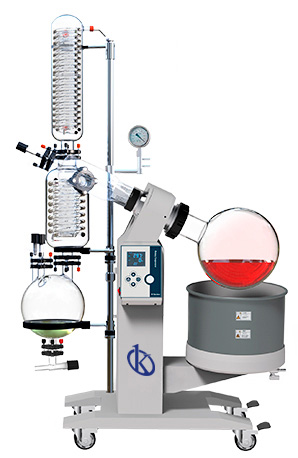A rotary evaporator or rotary evaporator is a laboratory equipment used to remove or recover low pressure solvents (reduced pressure distillation). That is, it is a device used to evaporate substances through the distillation process, to be condensed and finally separated into its components one by one, by using specific boiling points.
This instrument is much more efficient than a simple or conventional distillation equipment, due to the presence of a vacuum system that is coupled to its structure, and that by allowing the sample to rotate it generates a larger contact surface, which allows evaporation to occur faster, and also has a heating system that makes the distillation process more efficient and accurate.
How is a rotary evaporator composed?
A rotary evaporator consists essentially of an electric motor that rotates a tube attached to a frosted glass joint guide tube. The latter has attached to its structure a round-bottomed flask containing the dissolution. This allows a rotation movement to be maintained, with the flask partially submerged in the water. In the system there is a coolant that circulates a liquid (water or antifreeze), this generates the condensation of the solvent, which is recovered in a collector. Among its basic components are:
- A round flask to collect the distilled material.
- A vacuum equipment to reduce the internal pressure of the equipment.
- A height adjustable column and a spiral-shaped condensation column.
- An adjustable heating unit.
- A second round flask for evaporation.
- A pedestal for the rotation motor.
How does this computer work?
A rotary evaporator operates under the following scheme: the reduced pressure in the equipment causes the solvent to boil at a lower than normal temperature, and the rotation of the flask increases the surface of the liquid, resulting in faster evaporation speed.
The sample to be processed is inserted into the separation flask, which is immersed in the water, and then the thermoregulated bath and rotation system is ignited, then by the action of the vacuum pump, the pressure is reduced, allowing the solvents to be separated from the solutes, and that these solvents will be distilled into the condensation tube at low temperature and collected in the flask intended for it.
Uses and applications of a rotary evaporator
Rotavaporators are laboratory equipment widely used in various industries and institutions, such as:
- Chemical industry.
- Pharmaceutical industry.
- Food industry.
- Laboratories.
- Hospitals.
Benefits of a rotary evaporator
- The removal of the solvent by means of a rotary evaporator is superior to the common evaporation.
- The process with this equipment is much faster and more efficient.
- Use lower temperatures.
- Use less energy.
- It is very effective in removing the last traces of residual solvent in a solution.
What do we offer you in Kalstein?
At Kasltein we are manufacturers of laboratory equipment with a great track record, as we produce equipment of the highest category at unbeatable prices. This time we present our Rotary Evaporator YR02307 The large capacity flask with a large opening provides a larger evaporation surface. The evaporative flask continues to spin when constantly heated by a water bath, and the solvent evaporates more efficiently under vacuum conditions. It can be used for pilot scale production in biological engineering, pharmaceutical industry, chemical industry and food processing. It usually works with water circulation vacuum pump, diaphragm vacuum pump, recirculation cooler, constant temperature circulator, and low temperature circulation pump.
For more information we invite you to take a look at HERE

